THE PLOT TO ASSASSINATE ADOLF HITLER WAS CALLED OPERATION VALKYRIE AND THE FÜHRER'S LAST DAY
WAS SUPPOSED TO BE JULY 20, 1944. ERWIN ROMMEL WAS SUPPOSED TO BE HITLER'S REPLACEMENT. UNFORTUNATELY, SEPP DIETRICH—HITLER'S BODYGUARD—BETRAYED THE PLANS TO WINSTON CHURCHILL, WHO ORDERED 2 SPITFIRES TO ASSASSINATE ROMMEL INSTEAD! |
Winston Churchill—the Babylonian Bulldog—was the 20th century's version of King Richard the Babylonian Lyinheart. Winston became a "war hero" at the Battle of Omdurman in 1896 when he slaughtered a bunch of Fuzzy Wuzzies with a Maxim machine gun.
Likewise, King Richard I became known as "Lionheart" during the Third Crusade. It's easy to become a "war hero" when you own the opposition!
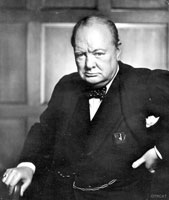 Warlord Winston Churchill (Nov. 30, 1874 –Jan. 24, 1965). Misruled Britannia from 1914 to 1965. |
|
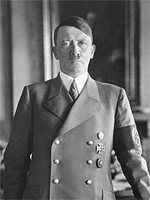 An Adolf Hitler doppelgänger was just 1 of 3 Führers from 1933 to 1945. |
The July 20 Plot was supposed to rid the world of the scourge of Adolf Hitler and his Third Reich. The man chosen to replace Hitler, and make peace with the Allies, was a famous field marshal named Erwin Rommel. Rommel was the "human face" of the Third Reich, whose reputation was not tainted by war crimes, or the massacre of POW's.
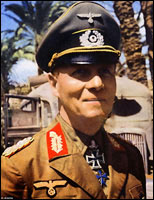 Field Marshal Erwin Rommel (1891– Oct. 1944). |
|
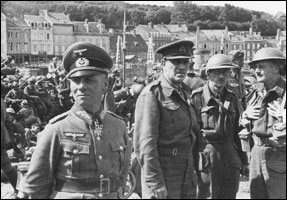 General Victor Fortune surrendering the British forces to Rommel, June 1940. |
Rommel, together with von Rundstedt, von Bock, and Kesselring, were the heroes of the 6-week Battle of France. That "cakewalk" convinced the Nazis that they were invincible, and they expected to repeat that victory when they invaded the Soviet Union.
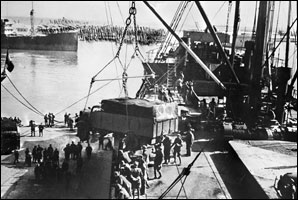 Unloading Nazi trucks at the port of Tripoli, Unloading Nazi trucks at the port of Tripoli, shipped via the Straits of Gibraltar. |
|
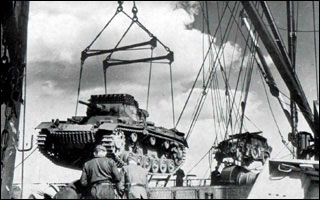 Unloading Nazi tanks at the port of Tripoli, Unloading Nazi tanks at the port of Tripoli,shipped via the Straits of Gibraltar. |
In February 1941, Rommel was appointed commander of the newly created Deutsches Afrika Korps. Initially, the Afrika Corps enjoyed spectacular success and Rommel gained a reputation as an invincible desert warrior.
Rommel was portrayed as a "good Nazi," and the war in North Africa was nothing like the slaughterhouse that was the Eastern Front.
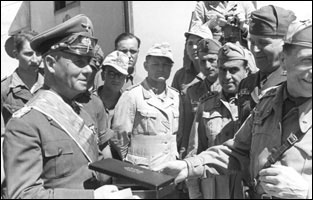 Rommel receiving congratulations on his Rommel receiving congratulations on his promotion to field marshal, June 1942. |
|
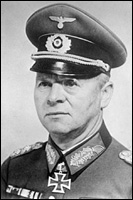 General Georg Stumme (1886– Oct. 1942). |
General Stumme originally served on the Eastern Front, where Hitler had a spy among the generals—his own bodyguard named Josep "Sepp" Dietrich. Dietrich reported to Hitler that Stumme had a "bad attitude," and Hitler wanted to get rid of him . . . but make it look like "enemy action."
In June 1942, some Nazi battle plans were captured by Russian forces. Hitler blamed Stumme and ordered that he be court-martialed. He was sentenced to 5-years imprisonment, but field marshal Fedor von Bock secured his release.
Herman Göring promised him a new command, so he was sent to replace Rommel. It was all a ruse to have him killed by the British so Hitler would not be blamed for his death.
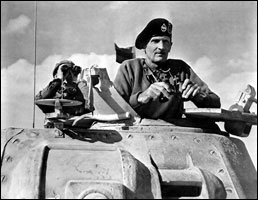 General Montgomery (1887– 1976) became a "war hero" in North Africa. |
|
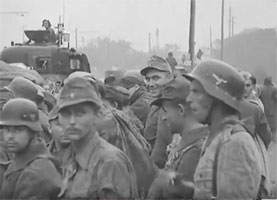 The vaunted Afrika Corps surrendered en masse in Tunisia, March 1943. |
In March 1943, the once "invincible" Afrika Corps surrendered to the British in Tunisia. However, that surrender did not cause Rommel to lose favor with Hitler.
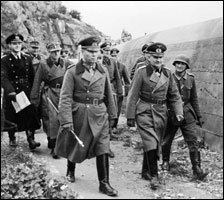 Rommel inspecting the Atlantic Wall, January 1944. |
|
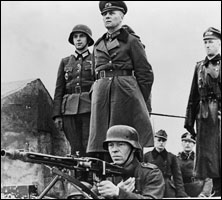 Rommel inspecting the beach defenses in Normandy, June 1944. |
It was in Normandy that Rommel first met Sepp Dietrich. Dietrich was Hitler's spy whose main job was to report back to the Führer on the attitude of all his top commanders. Additionally, Dietrich was given command of the 6th Panzer Division.
Sepp Dietrich—Hitler's bodyguard—was assigned to spy on Rommel
Josep "Sepp" Dietrich—the Bavarian butcher—was Hitler's bodyguard from the very beginning of his rise to power in Munich. A man with absolutely no military training, his ambition was to be a BUTCHER, until Hitler came along and offered him the chance to be a human butcher!
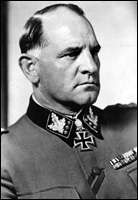 General Sepp Dietrich (1892–1966). |
|
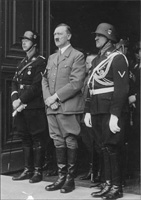 Hitler flanked by Dietrich and Himmler, April 20, 1937. |
As a Waffen-SS general, Dietrich was responsible for the massacre of Russian civilians on the Eastern Front. When Hitler gave the order that there was to be no retreat, Dietrich reported back to the führer the discontent among the generals. As a result, many generals were fired and replaced with sycophants.
Hitler never fully trusted Rommel—or any of his generals—so Dietrich was sent to spy on him and report his attitude back to his boss in Berlin.
Against vehement opposition from Churchill, the D-Day landings occurred on June 6, 1944. Once the beachhead was secured, Rommel could plainly see the handwriting on the wall.
2 RAF Spitfires almost assassinated Field Marshal Rommel
By the end of June 1944, not just Rommel, but most of the German high command could also see the handwriting on the wall. Only the most fanatical Waffen-SS believed in fighting to the bitter end.
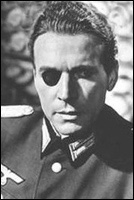 Claus von Stauffenberg (1907– July 21, 1944). |
|
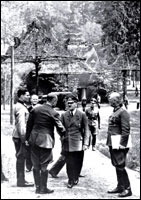 Von Stauffenberg and Hitler at the Wolf's Lair, July 15, 1944. |
Claus saw Rommel as the one man who could lead Germany after the elimination of Hitler and Himmler. The totally naive Rommel had to be sure that Sepp Dietrich was also on board, so he visited the Waffen-SS general at his HQ in Normandy.
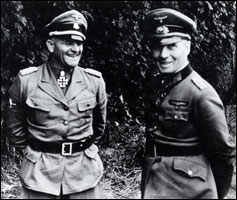 Sepp Dietrich and Rommel on July 17, 1944. |
|
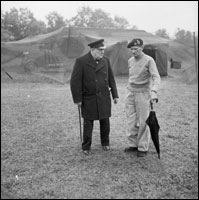 Churchill and Montgomery discussing the planned assassination of Rommel, July 1944. |
Sepp didn't have to ask twice because as soon as Rommel left, 2 Spitfires came roaring out of the sky, raining bullets down on Rommel's car:
Near Saint-Foy-de-Montgommery, Hoike spotted a formation of Allied fighters that appeared to be lining up for a strafing run on the road ahead. Rommel ordered Corporal Daniel to take a side road that ran through the village of Sainte-Germaine-de-Montgommery, and it was there that a pair of Royal Air Force Spitfires suddenly appeared. Daniel zigzagged desperately to throw off the British pilots' aim, but a burst of 20mm cannon fire walked across the road and into the car seriously wounding Daniel, who lost control of the big Horsch. The car skidded for 100 yards before it nosed into the ditch alongside the road, struck a tree and rebounded into the roadway again; everyone in the car was thrown clear by the initial impact. Rommel, who had turned to the right to watch the approach of the enemy fighters, was thrown violently against the windscreen pillar, fracturing his skull in three places and suffering massive injuries to the left side of his face before being tossed into the roadway. Unconscious and bleeding heavily, Erwin Rommel had come to the end of the war. (Butler, Field Marshal: The Life and Death of Erwin Rommel, p. 505).
Here is a description of that assassination attempt by Winston Churchill himself:
An important event now occurred. On July 17 Rommel was severely wounded. His car was attacked by our low-flying fighters, and he was carried to hospital in what was thought a dying condition. He made a wonderful recovery, in time to meet his death later on Hitler's orders. (Churchill, Triumph and Tragedy, p. 24).
Obviously, Churchill was very disappointed that Rommel was not killed by his Spitfires. It was left to his cousin Adolf to force Rommel to commit suicide.
Corporal Daniel the driver was killed instantly, and it was a miracle that Rommel escaped alive. His strong constitution from serving in North Africa helped him to recover from that attempted assassination!
Hitler had a doppelgänger at the Wolf's Lair conference room on July 20
Hitler had several doppelgängers, so nobody could be sure of the identity of the real Hitler. Charlie Chaplin—a Hitler look-alike—was actually born the same year as Hitler. Hitler decided to go along with the assassination charade so Himmler's Gestapo could cast its net far and wide and get rid of all the officers who opposed him.
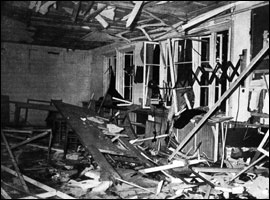 The bomb damage to the Wolf's Lair conference room was massive. |
|
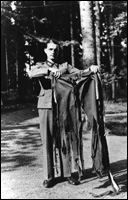 The doppelgänger's trousers. |
The massive explosion killed the doppelgänger and several of the officers. Von Stauffenberg was sure that Hitler was dead because he saw a man carried out on a stretcher covered with Hitler's coat.
Winston Churchill alluded to that event in his multi-volume history of the Second World War:
During the pause in the fighting in Normandy there took place on July 20 a renewed unsuccessful attempt on Hitler's life. According to the most trustworthy story, Colonel von Stauffenberg, had placed under Hitler's table, at a staff meeting, a small case containing a time-bomb. Hitler was spared from the full effect of the explosion by the heavy table-top and its supporting crosspieces and also by the light structure of the building itself which allowed an instantaneous dispersal of the pressures. Several officers present were killed, but the Führer, though badly shaken and wounded, arose exclaiming, "Who said that I am not under the special protection of God?" All the fury of his nature was aroused by this plot, and the vengeance which he inflicted upon all suspected of being in it makes a terrible tale. (Churchill, Triumph and Tragedy, p. 28).
The doppelgänger was definitely dead, and an unknown numbers of officers. The loyalty of those officers was questionable, so Hitler was glad to be rid of them.
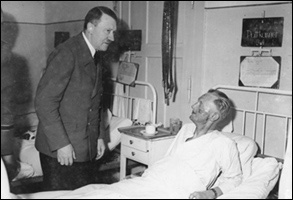 A Hitler doppelgänger visiting one of the survivors from the conference room explosion. |
|
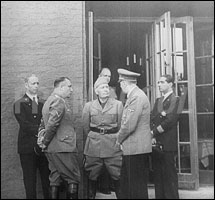 The doppelgänger meeting Mussolini on the afternoon of July 20. |
Von Stauffenberg flew back to Berlin to put Operation Valkyrie into operation. He was absolutely sure that Hitler was dead. He soon found out the awful truth that Hitler was alive and well, and the coup d'état had failed. Von Stauffenberg was placed before a firing squad and executed. Then his body was cremated. That was the fate of most of the July 20 plotters.
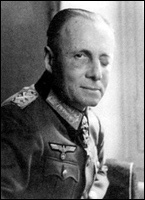 Rommel with a swollen eye after his return home, August 15, 1944. |
|
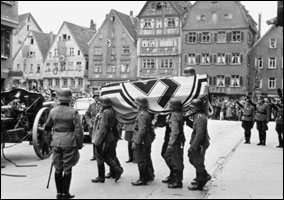 The funeral of Field Marshal Rommel, October 19, 1944. |
Rommel was given a state funeral with his coffin draped with a huge black spider flag. It was never even hinted that he was in any way disloyal to the Nazi regime.
Had the coup d'état succeeded, World War II might have ended in July 1944. There would have been no Battle of the Bulge, no Russian invasion of Germany, no Hiroshima and Nagasaki, no Holohoax, and no subsequent Cold War. Millions of lives were lost in the 9 months that followed the failed attempt to assassinate Hitler.
Sepp Dietrich killed American POW's during the Battle of the Bulge!
Before he was assigned to Normandy, Sepp Dietrich served on the Eastern Front where he committed war crimes against Russian prisoners and civilians.
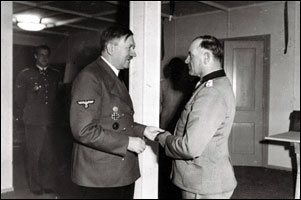 For saving his life, Dietrich received a special decoration from Hitler, August 10, 1944. |
|
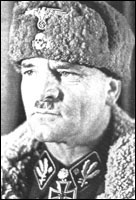 SS-Waffen commander Sepp Dietrich. |
Thanks to Ultra, the offensive was no secret to Churchill and Montgomery. HItler believed that the U.S. Army, without air cover, would be no match for his Waffen-SS fanatics. That battle became known as the Battle of the Bulge.
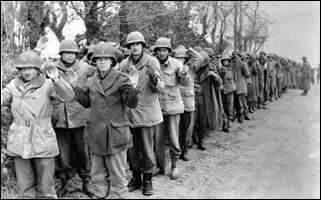 Americans surrendering to the Nazis Americans surrendering to the Nazis during the Battle of the Bulge. |
|
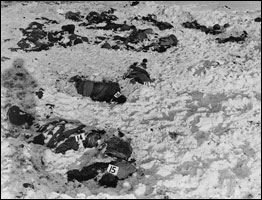 The Massacre at Malmédy. |
Surrender was not an option for General McAuliffe. When the Nazi commander von Lüttwitz sent him a surrender ultimatum, he gave his now famous reply "NUTS."
No amount of fanaticism could save the Nazis from defeat, and by January of 1945 they were in full retreat.
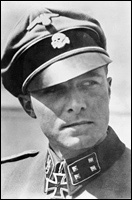 Colonel Joachim Peiper (1915–1976). |
|
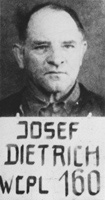 Dietrich was tried for the Malmédy Massacre after the war. |
While Hitler, Bormann, and Himmler escaped to Argentina, Peiper and Dietrich were captured and put on trial for war crimes. Both men were defended by a U.S. lawyer from Atlanta named Colonel Willis M. Everett, Jr. Everett claimed that the prisoners were tortured while in U.S. custody, and he appealed the case all the way to the U.S. Supreme Court.
Vital links
References
Beevor, Anthony. Ardennes 1944: The Battle of the Bulge. Penguin Random House, New York, 2015.
Butler, Daniel Allen. Field Marshal: The Life and Death of Erwin Rommel. Casemate Publishers, Pennsylvania and Oxford, England, 2015.
Caddick-Adams, Peter. Snow & Steel: The Battle of the Bulge, 1944–45. Oxford University Press, New York, 2015.
Churchill, Winston. The Second War War: Triumph and Tragedy. (Volume 6). Chartwell Edition, Houghton Mifflin Company, Boston, 1953.
Galante, Pierre. Operation Valkyrie: The German Generals Plot Against Hitler. Harper & Row Publishers, New York, 1981.
Messenger, Charles. Hitler's Gladiator: The Life and Wars of Panzer Army Commander Sepp Dietrich. Skyhorse Publishing, New York, 2011.
Remy, Steven P. The Malmedy Massacre: The War Crimes Trial Controversy, Harvard University Press, 2017.
Taylor, Blaine. Guarding the Führer: Sepp Dietrich & Adolf Hitler. Fonthill Media Limited, Stroud, Gloucestershire, U.K., 2015.